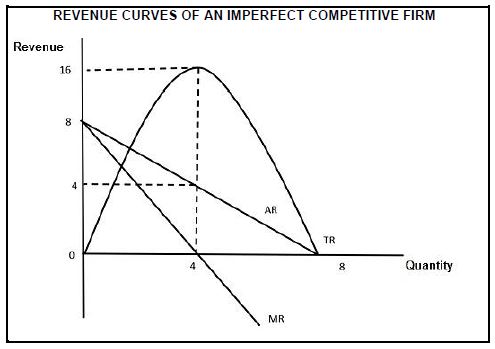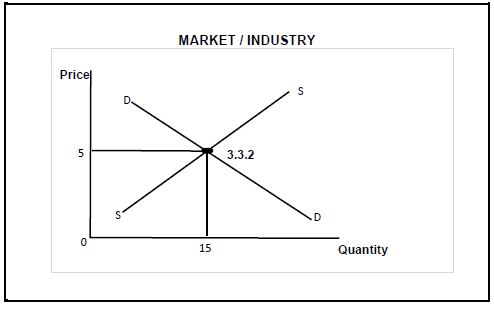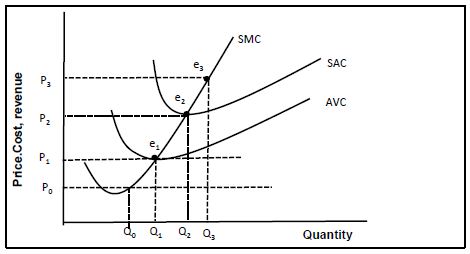ECONOMICS PAPER 2 GRADE 12 QUESTIONS - NSC PAST PAPERS AND MEMOS JUNE 2022
Share via Whatsapp Join our WhatsApp Group Join our Telegram GroupINSTRUCTIONS AND INFORMATION
- Answer FOUR questions as follows in the ANSWER BOOK:
SECTION A: COMPULSORY
SECTION B: Answer TWO of the three questions.
SECTION C: Answer ONE of the two questions. - Answer only the required number of questions. Answers in excess of the required number will NOT be marked.
- Number the answers correctly according to the numbering system used in this question paper.
- Write the question number above each answer.
- Read the questions carefully.
- Start EACH question on a NEW page.
- Leave 2–3 lines between subsections of questions.
- Answer the questions in full sentences and ensure that the format, content and context of your responses comply with the cognitive requirements of the questions.
- Use only black or blue ink.
- You may use a non-programmable pocket calculator.
- Write neatly and legibly.
SECTION A (COMPULSORY)
QUESTION 1 30 MARKS – 20 MINUTES
1.1 Various options are provided as possible answers to the following questions.
Choose the answer and write only the letter (A–D) next to the question numbers (1.1.1 to 1.1.8) in the ANSWER BOOK, for example 1.1.9 D.
1.1.1 The factors of production are completely mobile in a … market.
- perfect
- semi-perfect
- imperfect
- superficial
1.1.2 Unit cost is also known as … cost.
- marginal
- total
- average
- variable
1.1.3 Freedom of entry is a characteristic of a(n) …
- monopoly.
- oligopoly.
- duopoly.
- perfect market.
1.1.4 In comparison with perfect competition, a monopoly will …
- produce more and ask a lower price.
- produce less and ask a lower price.
- produce less and ask a higher price.
- produce more and ask a higher price.
1.1.5 When one dominant firm changes the price and others follow, it is regarded as price …
- leadership.
- taker.
- differentiation.
- discrimination.
1.1.6 A firm cannot recover … costs should it leave the industry.
- variable
- sunk
- fixed
- total
1.1.7 In any market the average revenue is the same as the …
- marginal revenue.
- supply.
- profit.
- price.
1.1.8 An example of a variable cost item is …
- insurance.
- electricity.
- rent.
- depreciation.
(8 x 2) (16)
1.2 Choose a description from COLUMN B that matches an item in COLUMN A. Write only the letter (A–I) next to the question numbers (1.2.1 to 1.2.8) in the ANSWER BOOK, for example 1.2.9 J.
| COLUMN A | COLUMN B |
| 1.2.1 Cartel 1.2.2 Fixed costs 1.2.3 Branding 1.2.4 Dead weight loss 1.2.5 Internal rate of return 1.2.6 Price discrimination 1.2.7 Firm 1.2.8 Marginal utility |
|
(8 x 1) (8)
1.3 Give ONE term for each of the following descriptions. Write only the term next to the question numbers (1.3.1 to 1.3.6) in the ANSWER BOOK.
Abbreviations, acronyms and examples will NOT be accepted.
1.3.1 The period in which all factors of production are variable
1.3.2 A non-recoverable cash payment to the producer of a commodity, with the view to reduce the price to the consumer
1.3.3 A curve that indicates combinations of goods or services that can be produced when the community's resources are fully and efficiently employed
1.3.4 The positive difference between revenue and cost
1.3.5 A study that is concerned with issues involving the economic behaviour of individual agents
1.3.6 The quantities of a good or service that potential buyers are willing and able to buy (6 x 1)
(6)
TOTAL SECTION A: 30
SECTION B
Answer any TWO of the three questions from this section in your ANSWER BOOK.
QUESTION 2: MICROECONOMICS 40 MARKS – 30 MINUTES
2.1 Answer the following questions.
2.1.1 List any TWO examples of industries that are operating under conditions of perfect competition. (2)
2.1.2 Why does the government sometimes set maximum prices for certain products? (2)
2.2 Study the information graph below and answer the questions that follow.
2.2.1 Identify the quantity at which total revenue is maximised. (1)
2.2.2 Which revenue curve represents a demand curve in an imperfect competitive firm? (1)
2.2.3 Briefly describe the concept marginal revenue. (2)
2.2.4 Briefly explain the significance of economies of scale. (2)
2.2.5 Why is the marginal revenue curve below the average revenue curve? (4)
2.3 Study the extract below and answer the questions that follow.
OLIGOPOLY AND PERFECT COMPETITION It is usually argued that many purchases that individuals make at the retail level are produced in markets that are neither perfectly competitive, nor monopolistically competitive, rather, they are oligopolies. Oligopoly arises when a small number of large firms have all or most of the sales in an industry. [Adapted from lumenlearning.com.] |
2.3.1 What is the number of sellers in a perfect competitive market? (1)
2.3.2 What is a market structure that is dominated by two firms? (1)
2.3.3 Briefly describe the concept production. (2)
2.3.4 How can non-price competition act as a barrier to entry in an oligopoly? (2)
2.3.5 Why do societies allow oligopoly firms to use their market power to make economic profit? (4)
2.4 With the aid of a graph, explain the economic loss of a firm in a perfect competitive market. (8)
2.5 Evaluate the economic benefits and drawbacks of an increase in the national minimum wage. (2 x 4) (8)
[40]
QUESTION 3: MICROECONOMICS 40 MARKS – 30 MINUTES
3.1 Answer the following questions.
3.1.1 Name the TWO segments of the kinked demand curve. (2)
3.1.2 Why is collusion not relevant in a perfect market? (2)
3.2 Study the examples below and answer the questions that follow.
COST-BENEFIT ANALYSIS EXAMPLES A decision has to be made on the project to choose. Cost benefit analysis showed the following: | |
| PROJECT 1 | PROJECT 2 |
| Total cost = R8 000 Earning total benefit = R12 000 Cost-benefit ratio = 1 : 5 | Total cost = R11 000 Earning total benefit = R20 000 Cost-benefit ratio = 1 : 81 |
3.2.1 What is the formula for cost benefit ratio? (1)
3.2.2 According to the information given above, which project should be chosen? (1)
3.2.3 Briefly describe the concept cost-benefit analysis. (2)
3.2.4 For what purpose does the government set a maximum price? (2)
3.2.5 Why does the government sometimes carry on with the project even if the private costs are more than the private benefits? (2 x 2) (4)
3.3 Study the graph below and answer the questions that follow.
3.3.1 Which market structure is represented by the graph above? (1)
3.3.2 Provide the correct label, in full, for 3.3.2 in the above-mentioned graph. (1)
3.3.3 Briefly describe the term industry. (2)
3.3.4 Explain the implication of a price-taker. (2)
3.3.5 Using the graph above, derive a demand curve of an individual producer. (4)
3.4 Distinguish, without using graphs, between productive and allocative inefficiency. (8)
3.5 Examine the consequences of an increase in the demand for a firm’s products in a perfect competitive market.(8)
[40]
QUESTION 4: MICROECONOMICS 40 MARKS – 30 MINUTES
4.1 Answer the following questions.
4.1.1 Name TWO market structures that sell homogenous products. (2)
4.1.2 What would happen if firms in an oligopolistic market compete in prices? (1 x 2) (2)
4.2 Study the information below and answer the questions that follow.
| ECONOMIST’S FIRM | ACCOUNTANT’S FIRM |
| Total revenue – R1 000 | Total revenue – R1 000 |
| Implicit costs (R75) | Explicit costs (R100) |
| Explicit costs (R100) | |
| Economic profit R??? (4.2.5) | Accounting profit R900 |
4.2.1 Give ONE example of an explicit cost. (1)
4.2.2 Provide a correct economic term for zero profit. (1)
4.2.3 Briefly describe the concept implicit costs. (2)
4.2.4 How is total revenue determined? (2)
4.2.5 Use the information above to calculate economic profit. Show ALL calculations. (4)
4.3 Study the extract below and answer the questions that follow.
COMPETITION TRIBUNAL APPROVES BURGER KING TAKEOVER The Competition Tribunal has given the green light for the acquisition of Burger King South Africa (BKSA) by a private equity fund. |
4.3.1 Identify from the extract above ONE objective of the Competition policy. (1)
4.3.2 Give ONE authority/institution of the Competition policy not mentioned in the extract. (1)
4.3.3 Briefly describe the concept competition as used in economics. (2)
4.3.4 How does the competition policy save businesses in South Africa? (2)
4.3.5 Why is the petrol market in South Africa regarded as an example of an oligopoly? (4)
4.4 Use the graph below to explain how the supply curve of a firm in a perfect competitive market is derived. (8)
4.5 How does collusion negatively impact the economy? (8)
[40]
SECTION C
Answer ONE of the two questions from this section in the ANSWER BOOK.
Your answer will be assessed as follows.
| STRUCTURE OF ESSAY | MARK ALLOCATION |
| Introduction The introduction is a lower-order response. • A good starting point would be to define the main concept related to the question topic. • Do NOT include any part of the question in the introduction. • Do NOT repeat any part of the introduction in the body. • Avoid mentioning in the introduction what you are going to discuss in the body. | Max. 2 |
| Body Main part: Discuss in detail/In-depth discussion/Examine/Critically discuss/Analyse/Compare/Evaluate/Distinguish/Differentiate/Explain/ Draw a graph and explain/Use the graph given and explain/Complete the given graph/Assess/Debate A maximum of 8 marks may be allocated for headings/examples. Additional part: Critically discuss/Evaluate/Critically evaluate/Debate/ Deduce/Compare/Distinguish/Interpret/How?/Suggest A maximum of 2 marks may be allocated for mere listing of facts. | Max. 26 Max. 10 |
| Conclusion Any higher-order conclusion should include: • A brief summary of what has been discussed without repeating facts already mentioned • Any opinion or valued judgement on the facts discussed • Additional support information to strengthen the discussion/analysis • A contradictory viewpoint with motivation, if required • Recommendations | Max. 2 |
| TOTAL | 40 |
QUESTION 5: MICROECONOMICS 40 MARKS – 40 MINUTES
- Compare and contrast in detail, without graphs, monopolistic competition and monopoly market structures. (26 marks)
- Why would government support or licence monopolies? (10 marks)
[40]
QUESTION 6: MICROECONOMICS 40 MARKS – 40 MINUTES
- Discuss in detail, without graphs, causes of market failure. (26 marks)
- Evaluate the use of indirect taxation to solve market failure. (10 marks)
[40]
TOTAL SECTION C: 40
GRAND TOTAL: 150


